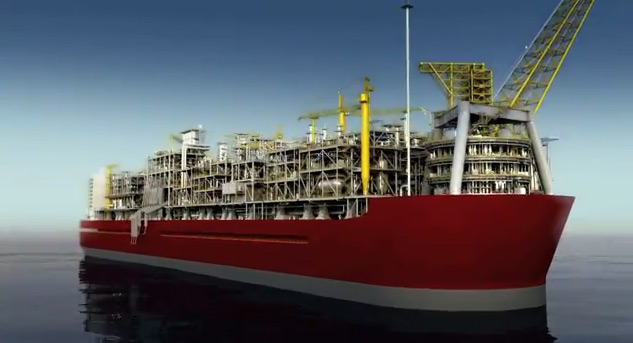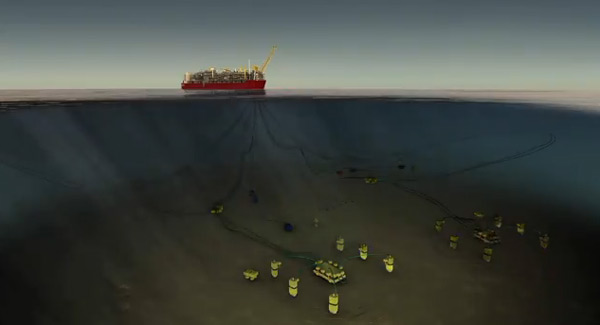Offshore gas production and processing
Floating Liquefied Natural Gas (FLNG) is a� ground breaking technology that allows for the extraction and processing of offshore gas resources. These resources could remain untapped because of the location of the resource which is trapped hundreds of kilometres into the ocean and under the ocean floor. FLNG is the most effective method of gas extraction and processing where land-based LNG processing plants are not commercially viable.
When we talk about FLNG, we are talking about a huge ship that is approximately the length of four football fields, some 488 metres in length and weighing in at 600,000 tonnes. This phenomenal floating gasiffication processing plant is 6 times larger than the largest aircraft carrier.
FLNG technology also provides a number of environmental and economic advantages because gas processing is completed at the gas field.
Long pipelines to shore, pumping stations, dredging and jetty construction, and onshore construction of an LNG processing plant are no longer required, which minimises the impact on the environment.

Once the gas has liquified on board the production ship, large LNG carriers will extract the liquefied gas from the storage tanks on the production ship and deliver to global markets.
This is an efficient way to get the gas from the underocean reserves, into the processing plant and onto ocean-going transport.
Finding more ways to unlock supplies of natural gas, the cleanest-burning fossil fuel, is helping to meet increased energy demand with less impact on the environment and creating more jobs in gas.
A world first
There are currently no FLNG facilities deployed anywhere in the world. Shell’s Prelude FLNG Project is likely to be the world’s first.

For Australia, the Prelude FLNG project will demonstrate a means of developing some of Australia’s “stranded” offshore gas reserves – those considered uneconomic for development via an onshore plant because they are too small or remote. The CSIRO estimates Australia has around 140 tcf of stranded gas.
The Woodside-led Sunrise Joint Venture has chosen FLNG as its preferred development concept to develop the Greater Sunrise gas fields in the Timor Sea.
Gas projects in the pipeline
The boom in demand for Australian natural gas from Asia, and the development of new sources such as coal seam gas from Queensland`s Bowen and Surat Basins, has sent export expectations soaring.
Add to that the new technologies such as Floating LNG which will increase production and lower infrastructure costs, the future of LNG`s looks very promising.
There have been many projects planned around the massive offshore gas fields of Western Australia:
- BHP-Billiton`s Macedon Project : www.bhpbilliton.com
- Browse LNG Project: Woodside jobs WA LNG
- Chevron`s Gorgon Project: Kimberly gas project
- Chevron`s Wheatstone LNG Project: Wheatstone operations
- Shell`s Floating LNG Project: Woodside jobs WA Browse basin
In Queensland:
- Arrow Energy LNG Plant Project: Woodside jobs western australian browse basin LNG
- Australia Pacific LNG Project: What is csg
- Curtis LNG Project: LNG jobs in australia
- Santos` Gladstone LNG Project: LNG Gladstone
In the Northern Territory:
Inpex`s Ichthys Project: LNG jobs in Australia
Four planned projects in Queensland make up about 25 per cent of the value and production of the country’s Liquified Natural Gas projects.
The Queensland Government plans to increase LNG exports to boost the state`s economy, reports ABC News. Treasurer Tim Nicholls said the intense increase in LNG production by 2016 will lead to extensive growth in overseas exports of 23 per cent, boosting economic growth in the state to 6 per cent.
Chief Operating Officer of The Australian Petroleum Production and Exploration Association Rick Wilkinson says the LNG industry has so far drilled 4,000 wells and pipelines from Roma to Gladstone, whilst three LNG plants are also under construction on Curtis Island.
According to Mr Wilkinson, 27,000 gas jobs have been created in the construction phase. Queensland`s economic outlook looks solid owing to the strong demand for LNG overseas, especially in Asia.� He said Asia is very thirsty for energy, as they go through their next development phase, so countries like China, Korea, Japan and Malaysia are all looking for abundant and close supplies of LNG.
LNG projects being built in Queensland have contracts in place for the next 20 plus years�and beyond.

 Read about how to get jobs in gas
Read about how to get jobs in gas